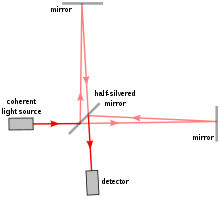User talk:Martin Hogbin/Speed of light/Aether
Proposed new section[edit]

After the work of James Clerk Maxwell, it was believed that light travelled through the "luminiferous aether", the medium that was then thought to be necessary for its transmission, [1]its speed being determined by the aether's permittivity and permeability . Because light travels with immense speed and is a transverse wave, the aether was assumed to be extremely rigid and solid rather than fluid. On the other hand, it apparently offered no resistance to the motions of the moon and planets. Maxwell’s equations allow the speed of light to be calculated, in much the same way as the speed of sound can be calculated in normal matter. The speed of sound in a medium is relative to the the medium itself, and the speed of sound with respect to an observer may be changed if the observer is moving with respect to the medium. The speed of light was believed to be relative to the medium of transmission for light (the aether), which acted in the same way that a solid does for the transmission of sound.

In 1887, the physicists Albert Michelson and Edward Morley performed the influential Michelson–Morley experiment[2] to measure the velocity of the Earth through the aether. As the Earth is in orbit round the sun, and the aether was assumed to be fixed, the Earth would be expected to be in motion with respect to the aether for at least some of the time[3]. As shown in the diagram of a Michelson interferometer, a half-silvered mirror was used to split a beam of monochromatic light into two beams traveling at right angles to one another. After leaving the splitter, each beam was reflected back and forth between mirrors several times (the same number for each beam to give a long but equal path length; the actual Michelson-Morley experiment used more mirrors than shown) then recombined to produce a pattern of constructive and destructive interference. Any slight change in speed of light along one arm of the interferometer compared with its speed along the other arm (because the apparatus was moving with the Earth through the proposed "aether") would then be observed as a change in the pattern of interference. In the event, the experiment gave a null result. Later experiments confirmed this result to a much higher accuracy. [4][5]
The Michelson–Morley null result disproved the original rigid fixed aether theory and no scientist has since succeeded in elaborating a mechanical model for the aether which would furnish a satisfactory mechanical interpretation of Maxwell's laws of the electro-magnetic field. [6] Ernst Mach was among the first physicists to suggest that the experiment amounted to a disproof of the aether theory.
The null result also led Lorentz to propose that motion through the aether contracts the Michelson interferometer due to Fitzgerald-Lorentz contraction[7], and later to propose his Lorentz transformations which formed the mathematical basis of Einstein's special theory of relativity. Although it uses the Lorentz transformations, Einstein's theory explains the null result of the Michelson–Morley experiment by postulating that the speed of light is always the same for all inertial observers. This means that the speed of light speed will always be the same in both arms of the interferometer, regardless of their orientation or state of inertial motion, thus no changes in the observed fringes would be expected when it was rotated. The postulates that the speed of light is the same for all inertial observers and the equivalence of inertial frames, are the the fundamental postulates of special relativity.
It is uncertain whether Albert Einstein knew the results of the Michelson-Morley experiment when he developed his theory, but the null result of the experiment greatly assisted the acceptance of his theory of relativity. After Einstein published his general theory of relativity, which extended his special theory to include gravitation, the concept of aether rapidly fell into disuse and it forms no part of physics today.
Footnotes[edit]
- ^ For discussions of the aether, see
- J. Larmor (1900). Aether and Matter: A Development of the Dynamical Relations of the Aether to Material Systems on the Basis of the Atomic Constitution of Matter. Cambridge University Press.
- J. Larmor (1895). "A dynamical theory of the electric and lumiferous medium. Part II; theory of electrons". Proceedings of the Royal Society. Vol. 58. pp. 222–228. doi:10.1098/rspl.1895.0036.
{{cite conference}}: Unknown parameter|booktitle=ignored (|book-title=suggested) (help)
- ^ A A Michelson, E W Morley, Am J Sci,34n (1887) 333
- ^ Berkley Physics Course, Vol 1, Kittel, Knight, Ruderman, Helmholtz, Moyer, McGraw Hill, ISBN 0-07-004880-0 pp312-317
- ^ R C Cialdea, Lett Nuovo Cimento 4 (1972) 821
- ^ D C Champeny, G R Isaak, andA M Kahn, Phys Lett 7 (1963) 241
- ^ Aether and the Theory of Relativity by Albert Einstein, PhD, Address delivered on May 5th, 1920, at the University of Leyden, Germany.
- ^ H A Lorentz,Verh K Akad Wet 1 (1892) 74
